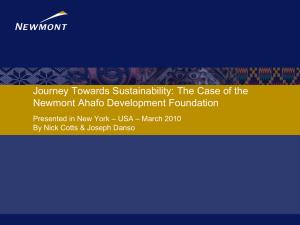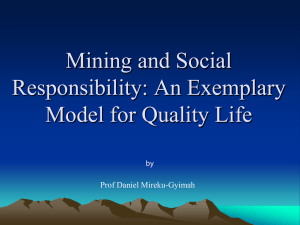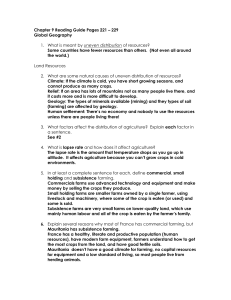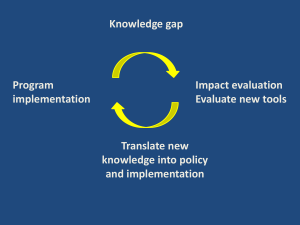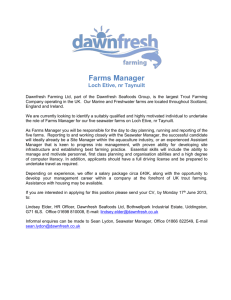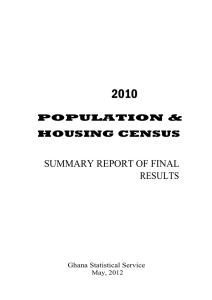Anderson – CO School of Mines case study May 14 2015
advertisement
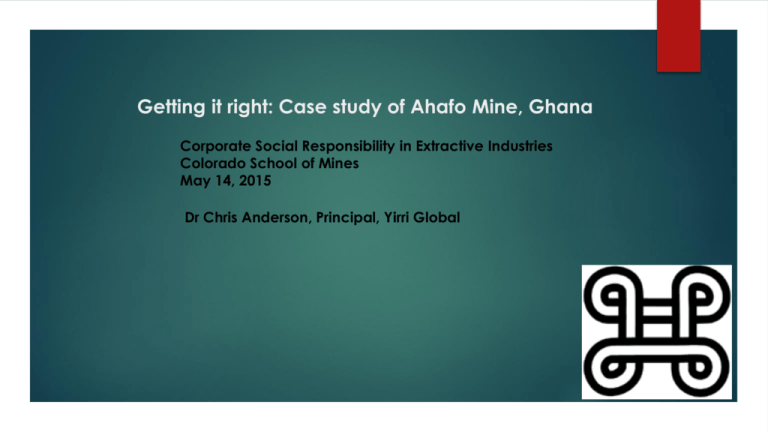
Getting it right: Case study of Ahafo Mine, Ghana Corporate Social Responsibility in Extractive Industries Colorado School of Mines May 14, 2015 Dr Chris Anderson, Principal, Yirri Global Ahafo: Introduction Gold mine in central Ghana, Brong Ahafo Region; first country in Africa to gain independence (1957); series of coups in 80s, but democratic and peaceful elections and transitions since late 1990s. Ghana ancient gold producer; modern gold mining last 100 years; mostly state-owned. Ahafo: 17 years from first discovery to production, 14 different deposits- ‘string of pearls’ along 50km strike; five different ownerships; construction began under Newmont in 2003; first production 2006; 400-500k oz p.a. Newmont investment agreement signed with Parliament in 2003. Farming area; no previous gold mining. No industry other than subsistence and market farming. 180,000 people in ten villages. Chiefdom institution very strong. Remnant rain forest but mostly farm land (2 acres average; plantain, tomatoes, chili pepper, cocoa; cassava, etc.) National language is English. Ca 20 other languages. Social & environmental context No modern industrial work history in region No previous dealings with large companies Lack of gold mining experience a good thing (no direct bad legacy) Local government capacity low People and their farms on top of deposits. Resettlement required IFC funding and therefore Performance Standards Good national EPA regulation on environmental side; not so much on social Low levels of education; local languages though most community leaders speak English. Health issues include malaria and HIV/AIDS. Social & environmental consequences Resettlement of 10k people in 18 months Decisions on access to land for resettled people and their farms Alternative livelihoods & compensation Sustainable development (as opposed to handing out money or company doing everything) Speculation on land and farms Up to 8k direct jobs. 50k indirect and induced jobs nationally Training; move from construction workforce to operation and transition training Local supply emphasis (empowering local entrepreneurs – e.g. Alexi Boampong) Implementation of CSP ASRF and consultation vehicles Local employment processes Local supply process & linkages program Payments to government transparency New funding basis via Foundation Newmont Ahafo Development Foundation Management of influx Malaria and HIV/AIDS programs Partnerships (Education, Health, Local Government capacity-building) AAGI; Vulnerable Peoples; women’s programs Grievance management system Social outcomes of Ahafo Mine Partial transformation of economy to wages work and commercial supply Larger scale agriculture & shift from substance to market farming Price increases for local goods Dramatic increase in wage employment & local businesses Significant increases in farmer income Involvement of community in decision-making; increased capacity all around Dramatically better communication infrastructure Safety culture Sustainable community development via NADEF Lower malaria and HIV/AIDs rates Not a single operational day in nine years lost due to community unrest.
